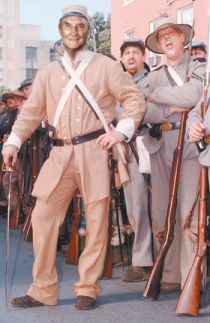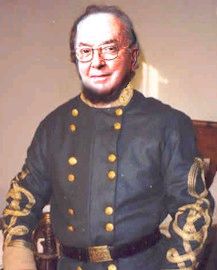Strom Thurmond
and Jesse Helms:
Civil War Heroes
When you think of Strom Thurmond and Jesse Helms, you tend to think of shriveled-up old prunes that have no business determining the fate of a nation that is no longer held together by a network of river barges and canals, bearing the nation's freight from the frontier towns along the Ohio down to the port of New Orleans. You would be right in that respect. But did you know these two men served proudly in the War Between the States? I'm sure you thought they were sure old enough to have been around at the time. Here's what Zzzptm Historical Researchers have dug up on the two:
 Strom Thurmond was a full Colonel at the time of the outbreak of the War Between the
States. He had been part of Robert E. Lee's graduating class at West Point. Like Lee and many other of the officers of the Confederacy, he served with
distinction in the Mexican War, earning the rank of brevet-Captain after the
battle of Cerro Gordo. Although he fought bravely in the campaign, he was not aloof from the
behind-the-scenes maneuvers to discredit General Winfield Scott's leadership
of the Veracruz-Mexico City campaign, as many historians will tell you.
Capt. Thurmond and Generals Pillow and Worth were incessantly needling old
Gen. Scott from the time they encamped at Puebla to recover from outbreaks of Yellow Fever and await replacements after the volunteers serving in the US Army went home, on up to the final battles of the campaign in the "Halls of Montezuma" outside Mexico City. After the war, Thurmond became a career officer in the army. When South Carolina seceded from the United States, Thurmond was among the first officers from that state to resign their commissions in the US Army and accept a rank in the forces of the CSA.
Strom Thurmond was a full Colonel at the time of the outbreak of the War Between the
States. He had been part of Robert E. Lee's graduating class at West Point. Like Lee and many other of the officers of the Confederacy, he served with
distinction in the Mexican War, earning the rank of brevet-Captain after the
battle of Cerro Gordo. Although he fought bravely in the campaign, he was not aloof from the
behind-the-scenes maneuvers to discredit General Winfield Scott's leadership
of the Veracruz-Mexico City campaign, as many historians will tell you.
Capt. Thurmond and Generals Pillow and Worth were incessantly needling old
Gen. Scott from the time they encamped at Puebla to recover from outbreaks of Yellow Fever and await replacements after the volunteers serving in the US Army went home, on up to the final battles of the campaign in the "Halls of Montezuma" outside Mexico City. After the war, Thurmond became a career officer in the army. When South Carolina seceded from the United States, Thurmond was among the first officers from that state to resign their commissions in the US Army and accept a rank in the forces of the CSA.
Jesse Helms was a lad of 13 when he enlisted in 1861. He served in the 2nd North Carolina Regulars, a "Zouave" outfit
that was cut to ribbons in the early battles of the war. After a uniform
change, the unit had a substantially higher survival rate, although they had
to endure lower recruitment numbers now that they no longer had as handsome
a uniform.
Colonel Thurmond saw considerable action in the Western and Southern theaters of the war, as his troops dogged first Grant, then Sherman, as they battled through the Southland. He was wounded at Vicksburg, but carried on fighting until the Confederate surrender in 1865. His Vicksburg wounds trouble him to this day, causing him to walk with a slight limp.
 Helms' unit saw action in the battles of Bull Run and Cold Harbor. It was pulled back for garrison duty after losing 80% of its strength and missed the remainder of the action in Virginia that year. It was brought back to full strength in time to accompany Lee's march into Pennsylvania, where Helms' unit fought off Custer's cavalry, doing its best to protect the Southern supply lines. Consequently, he missed the tremendous bloodbath at Gettysburg. He was later to say, "I am sorry I did not have a chance to lay down my life for my country there, but I am glad I was able to live on in service to my homeland." By 1865, Helms was a sergeant and had been wounded twice in action.
Helms' unit saw action in the battles of Bull Run and Cold Harbor. It was pulled back for garrison duty after losing 80% of its strength and missed the remainder of the action in Virginia that year. It was brought back to full strength in time to accompany Lee's march into Pennsylvania, where Helms' unit fought off Custer's cavalry, doing its best to protect the Southern supply lines. Consequently, he missed the tremendous bloodbath at Gettysburg. He was later to say, "I am sorry I did not have a chance to lay down my life for my country there, but I am glad I was able to live on in service to my homeland." By 1865, Helms was a sergeant and had been wounded twice in action.
After the war, Helms returned to his simple North Carolina truck farm, barely 17 years old. Thurmond had to surrender his sword and was threatened with a trial on charges of treason. That trial never materialized and Thurmond considered a life of politics once Reconstruction ended in South Carolina. He was first elected to the Senate in 1884, and has served in that body ever since. Helms entered the Senate shortly after the turn of the century, where he and Thurmond now hold the distinction of being the only Civil War veterans still serving actively in the U.S. Senate.